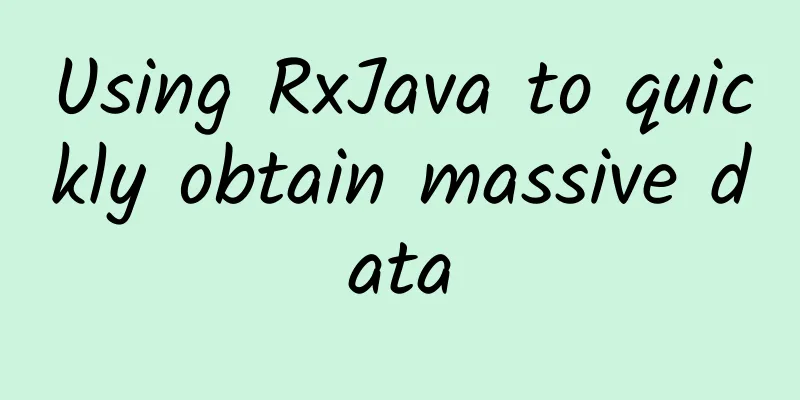Using RxJava to quickly obtain massive data

|
Imagine that when you need some dynamic data, you only need to request the network every time. However, a more efficient approach is to cache the data obtained from the network to disk or memory. Specifically, the plan is as follows:
I will implement this plan by using RxJava. Basic Mode Create an Observable<Data> for each data source (network, disk, and memory) and use the concat() and first() operators to construct a simple implementation. The concat() operator holds multiple Observable objects and concatenates them into a queue in order. The first() operator only takes and emits the first event from the concatenated queue. Therefore, if you use concat().first(), no matter how many data sources there are, only the first event will be retrieved and emitted.
The key to this pattern is that the concat() operator subscribes to all Observable sources only when data is needed. Since the first() operator stops retrieving the queue early, there is no need to access the slower source if there is cached data. In other words, if memory returns the result, there is no need to worry about disk and network being accessed. Conversely, if there is no data in memory or disk, the network request is performed. Note that the Observable data sources held by concat() are retrieved one by one in order. Persistent Data Obviously, the next step is to cache data. If you don't cache the results of network requests to disk, and cache the results of disk accesses to memory, then it's not called caching at all. The next code to write is to persist the network data. My solution is to have each data source save or cache the data after sending the event.
Now, if you use networkWithSave and diskWithCache, the data will be automatically saved after loading. (Another advantage of this strategy is that networkWithSave and diskWithCache can be used anywhere, not just in our multi-data model.) Stale data Unfortunately, right now the code we have that saves the data is overdoing it. It always returns the same data, regardless of whether it's out of date or not. We want to occasionally connect to the server and grab the latest data. The solution is to use the first() operator to filter, which is to set it to reject worthless data.
Now, we only need to send events that are determined to be the latest data. Therefore, as long as the data of one data source expires, we will continue to retrieve the next data source until the latest data is found. Comparison of first() and takeFirst() Operators For this design pattern, either first() or takeFirst() operators can be used. The difference between the two calling methods is that if the data of all data sources are expired and no valid data is sent as an event, first() will throw a NoSuchElementException (Translator's note: the first() operator always returns false), while the takeFirst() operator will directly call the completion operation without throwing any exception. Which operator to use depends entirely on whether you need to explicitly handle missing data. Code Sample You can check out a sample implementation of all the above code here: https://github.com/dlew/rxjava-multiple-sources-sample. If you need a real-world example, check out the Gfycat App, which uses this pattern when fetching data. The project doesn’t use all of the features shown above (because it doesn’t need to), but it demonstrates the basic usage of concat().first(). |
<<: Apple lowers its profile to make money: Watches are on retailers' shelves
>>: Who created the programmer bubble?
Recommend
Promotional Marketing: How to Start a Trend?
Lee Seung-ri, an artist from the South Korean boy...
Marketing promotion: 6 ways to make your ads more memorable
There are thousands of ideas popping up in this w...
See the strong insertion of AspectJ in Android
What is AOP AOP is the abbreviation of Aspect Ori...
Consumer demand still exists, home appliance companies focus on the third and fourth tier markets
With the influence of national policies, the spee...
Taoist "Yin Pan Qi Men Dun Jia" training course video lecture
Qi Men Dun Jia course, this course is 1.96 GB in ...
Who is using Win10 like this?
As an important part of Windows 10's multi-sc...
Ministry of Industry and Information Technology: 14 apps failed to strictly implement the rectification requirements for pop-up information harassing users, including QQ Reading
IT Home reported on July 28 that according to the...
“Eight beavers built a dam in two days that took the Czech Republic seven years to build.” Are these “beavers”?
Beavers, cute large rodents, have been in the new...
Want to "fly over" the traffic jam ahead? This high-tech car can actually fly into the sky! The scientific principle behind it is...
When you are stuck in traffic, you often have thi...
China Passenger Car Association: China's auto sales in January-February 2025 will reach 13.52 million units, accounting for 33.7% of the global market share
According to recent news, Cui Dongshu, secretary-...
Interesting fact: Can human organs be replaced?
Throughout the ages, organ replacement has always...
Li Xiubao: Planting corals on the seabed to protect the "tropical rainforest in the blue ocean"
(Li Xiubao, Professor of the College of Oceanogra...
Musk's plan to control the human brain has taken another step forward. Westlake University has developed a 1 square millimeter neural chip. Are you ready to install a chip in your brain?
The girl, with only her brain intact, was revived...
How did “GunGun” turn himself into a “living fossil”?
Do you know the answers to these questions about ...









